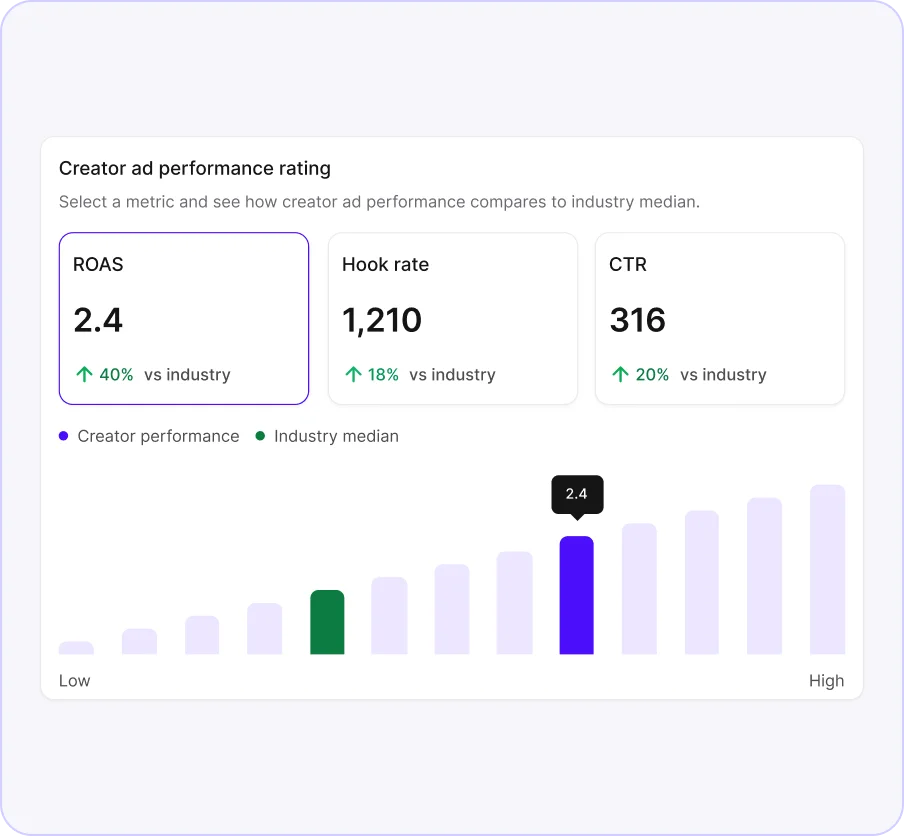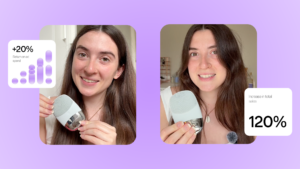What Is Performance Based Marketing? + Data-Driven Case Studies
Passionate content and search marketer aiming to bring great products front and center. When not hunched over my keyboard, you will find me in a city running a race, cycling or simply enjoying my life with a book in hand.

In a digital ad landscape shaped by rising CPMs and stricter privacy regulations, performance based marketing is becoming non-negotiable for growth-minded brands. Instead of paying for reach or impressions, brands only pay when real results happen – clicks, leads, purchases. It’s a shift toward accountability that makes every dollar work harder.
In this blog, we’ll break down what performance based marketing actually looks like in 2025, plus showcase real-world examples and proven tactics from brands like UberEats, Glossier, and Gymshark that have driven massive ROAS and reduced CAC at scale.
TL;DR:
- Performance based marketing is accelerating in 2024-2025 due to rising demand for ROI clarity.
- Brands only pay for results (clicks, installs, or purchases) boosting efficiency.
- UGC and creator-led ads dominate, especially when tied to performance comp.
- Real examples (UberEats, Gymshark) show 2×+ ROAS and 30–50% CAC drops.
- Winning brands test fast, optimize hooks, and align creator pay with outcomes.
What is Performance Based Marketing?
Performance based marketing is a results-driven strategy where brands only pay when specific actions like clicks, leads, or purchases are achieved. This makes it one of the most accountable models for digital advertising in 2025.
This model shifts ad spend from guesswork to guaranteed outcomes, ideal for brands focused on ROAS and scale.
There are several core models used for this practice. The most popular being:
- Cost-per-click (CPC): Pay when someone clicks your ad.
- Cost-per-lead (CPL): Pay when a lead (like an email or signup) is generated.
- Cost-per-acquisition (CPA): Pay only when a customer completes a purchase.
- Revenue share (affiliate marketing): Pay a percentage of each sale generated.
In most cases, such models are used on platforms such as:
- Paid search (e.g., Google Ads)
- Paid social (e.g., Meta, TikTok)
- Affiliate networks
- Creator marketplaces with performance-based comp
Performance Base Marketing Tools
Performance based marketing campaigns are often optimized using tools like pixel-based attribution, dynamic A/B testing, and real-time budget shifts based on ROI performance. Brands also lean on KPIs like CTR, CPA, and ROAS to track results in real time.

Influencer Marketing Hub and HubSpot both outline how these models help brands stay lean and adaptive. For more on campaign tracking, see our guide on ad performance metrics.
Why Brands Are Moving Toward Performance Based
As ad costs rise and budgets tighten, performance based marketing offers a smarter path: brands only pay when campaigns deliver. That risk-reduction is a major draw in 2025.
First, it helps brands stay lean. Instead of paying upfront for media, marketers can align spend with real outcomes – whether that’s a click, install, or conversion. According to WordStream, this model is particularly valuable when CPMs spike and CFOs want tighter spend accountability.
Second, performance marketing fuels rapid iteration. Brands can test and tweak creatives, hooks, and messages based on real-time metrics like hook rate, hold rate, and conversions. This lets teams double down on what’s working and cut what’s not. Learn more in our guide on hook rate to hold rate.
Finally, this model is especially effective for UGC and creator partnerships. Brands can pay creators based on performance rather than fixed rates – ensuring better alignment and results. As AdRoll notes, this approach builds more trust and impact by linking compensation to outcomes.
Performance based marketing is not just more efficient, it’s how the most agile brands are winning in a high-cost, low-margin ad environment. Explore Billo’s Performance Hub to get insights on your ads.
Performance Based Marketing Examples
To see performance based marketing in action, let’s break down 10 standout campaigns from brands that used this model to drive results:
Gymshark: Data‑driven influencer pay-off
Gymshark built its rise on influencer marketing (partnering with fitness advocates across TikTok, Instagram, and YouTube) and continuously measured ROI using detailed metrics like engagement, CTR, conversion rates, and brand sentiment.
Their data‑driven suggestions approach allowed them to scale influencer partnerships that directly moved the needle on sales, turning social buzz into reliable revenue generation.
Bumble: 5× app installs lift via TikTok influencers
In a performance-driven pivot, Bumble partnered with popular TikTok influencers and ran direct response ads, linking compensation to app installs and registrations. Between March and May 2020, this campaign boosted installs by 5× and cut cost‑per‑registration by 64%.
Dramatically lowering acquisition costs and showing the power of performance-based ad spend in social video channels.
Oura Ring: 2.75× average ROAS with holiday UGC ads
Oura Ring revamped more than 100 ad assets across Facebook, Instagram, and Google – emphasizing dynamic UGC formats over static creative. During a holiday campaign aimed at boosting brand performance, this performance-based approach delivered an average ROAS of 2.75×.
Solid proof that outcome-tied investments in creator-style ads can drive significantly better returns than traditional ads alone (Mayple case study).
Good Protein: 24% more conversions with iterative UGC
Good Protein used a performance based marketing model focused on iterative UGC testing. By continually adjusting creative elements, like hooks, CTAs, and visuals, they optimized for engagement and conversion. This agile approach resulted in a 67% engagement rate and a 24% lift in conversions compared to non-UGC branded ads.
Their success underscores how rapid testing with outcome-tied compensation leads to scalable creative wins (Billo Case Study).

Airbnb: UGC campaign boosts trust and organic bookings
Airbnb leveraged user-generated content in a performance-driven influencer campaign aimed at amplifying trust and boosting organic traffic. By collaborating with creators who shared authentic home-stay experiences and tracking conversion KPIs, the platform significantly improved engagement and bookings.
One campaign garnered over 1.9 million impressions and 62,000 likes in just one week through a duo of carefully chosen influencers (NeoReach).
Heinz: Viral TikTok campaign with massive engagement
Heinz launched a performance-driven TikTok campaign centered on its innovative “Flip & Squeeze” packaging, encouraging users to share creative condiment uses via the #HeinzFlipSqueeze hashtag. The campaign produced an astonishing 4.8 billion views, with 2,400+ UGC videos created, demonstrating massive organic reach and user engagement.
This scaled momentum directly translated into purchase intent increases of up to 30 percentage points across key markets, proving how outcome-tied UGC can transform cultural buzz into real business impact.
Sephora: TikTok Video Shopping Ads drive conversions
Sephora implemented a performance-based TikTok campaign using Video Shopping Ads, optimized specifically for conversions. They created two ad groups – one focused on prospecting and another on retargeting to drive viewers straight to product pages.
The results were outstanding: a 40% increase in completed purchases and a 29% decrease in cost per action compared to similar campaign types, marking their best ROAS performance to date.
Best Practices & Tactics For 2025
As performance based marketing becomes the go-to strategy for ROAS-conscious brands, a few tactics separate the winners from the rest. Here’s how top-performing teams are planning and executing in 2025:
1. Start with clear outcome metrics.
Before launching, define your “north star” KPI – whether it’s CPA, ROAS, CTR, or installs. Your creative, creators, and copy should all ladder up to this goal. This focus is what allows performance-based campaigns to optimize meaningfully over time.
2. Test small, then scale fast.
Don’t guess what works – run micro-tests on UGC variations (hook, CTA, script length) and double down on top performers. Iteration is the core of performance growth. Check out our guide to smart ad iterations to see how to build this muscle.
3. Optimize your hook rate.
The first 3 seconds of your video make or break it. Hook rate and hold rate tell you what’s grabbing attention—and what’s not. Use scroll data to fine-tune intros and get more out of every creative. Learn how to measure and improve hooks.
4. Align creator pay to performance.
Top brands now use hybrid comp: a base rate + performance bonus, or straight CPA-based models. This motivates creators to deliver results, not just content.

5. Use creative performance platforms.
Tools like Triple Whale, Motion, and Billo make it easy to track results across channels and creators. With dashboards that surface top performers and automate reporting, these tools are becoming essential to modern creative ops.
Success in 2025 means thinking like a growth marketer: optimize fast, pay for outcomes, and turn every creator into a performance partner.
Continue learning:
Summary & Next Steps
Performance based marketing isn’t just a trend, it’s the new standard for brands serious about measurable growth. In a world of rising ad costs and shrinking margins, paying for actual outcomes is the smartest path forward.
To succeed, brands must pair UGC with data-backed ad testing, align creator pay with results, and move fast on what performs. The examples from Oura to UberEats prove that when you tie spend to impact, every campaign gets sharper and every dollar goes further.
Ready to turn UGC into ROI?
Start optimizing your creator content for performance with Billo. Explore ad metrics, fine-tune your CTR benchmarks, and explore creators with proven performance to build your next high-performing campaign.
FAQs
What channels work best for performance based marketing?
Meta, TikTok, Google Ads, and UGC platforms like Billo are ideal. These channels support outcome-based tracking and are optimized for creator-led content.
How does UGC fit into performance strategies?
UGC consistently outperforms branded content in both CTR and retention. It’s authentic, scalable, and perfect for pay-per-performance models.
What KPIs are most important to track?
ROAS, CTR, CPA, hook rate, hold rate, and cost-per-action are the top metrics. Choose based on your campaign goals and optimize accordingly.
How should brands compensate creators in this model?
Use hybrid models – fixed base + performance bonus, or straight CPA depending on the creator’s audience quality and trust alignment.
SEO Lead
Passionate content and search marketer aiming to bring great products front and center. When not hunched over my keyboard, you will find me in a city running a race, cycling or simply enjoying my life with a book in hand.

Authentic creator videos, powered by real performance data
22,000+ brands use Billo to turn UGC into high-ROAS video ads.
From Guesswork to Growth: A Practical Creative T...
Ad-hoc creative testing often produces noisy results. When multiple variables [...]...
Read full articleTesting Ad Variations: How to Consistently Lift ...
Most performance gains come from better creative, not targeting tweaks. [...]...
Read full articleAI‑Driven Creative Coaching: How Machine Learn...
Creative is no longer just a variable – it’s the [...]...
Read full article




